4.Current Challenges of Using Spray Drones
RESOURCES - PUBLICATIONS
The Evolution of Spray Drones, Their Capabilities and Challenges for Pesticide Applications
4. Current Challenges of Using Spray Drones

THE DOWNSIDES OF SPRAY DRONES
Although using drones in agricultural settings can be positive, there are some downsides you should consider
While there are many benefits associated with using spray drones, there remain issues, questions, and concerns that users should consider before purchasing a drone and using them to apply pesticides. We describe some of these considerations on the following pages.
DRONE CONSIDERATION: High Volume
Drones cannot currently compete with ground rigs for applications that require high carrier volumes.
DRONE CONSIDERATION: Pesticide Labels Lack Drone Information
In states where approved, spray drones could apply pesticides as long as the pesticide includes aerial applications on the product label. However, spray drone applications must still follow all of a pesticide label’s aerial application requirements, which could be a challenge because these requirements were typically written for traditional fixed wing aircraft or helicopters.
Some pesticide labels specify that if applicators cannot follow all aerial application requirements on the label, then applicators should not apply the product. This presents a challenge for spray drones with unique qualities that set them apart from traditional aerial applications, such as travel speed, rates, and nozzle configurations. For example, many pesticides require a minimum spray volume of 5-10 gallons per acre, which spray drones may not be capable of providing. It is feasible for spray drones, but it just reduces the acreage completed per day and often increases the cost.
While both traditional aircraft and drones dispense pesticides from the air, there are likely many differences between traditional airplane and drone applications operating under standard procedures. The biggest one is the spray dynamics between both methods. Aerial application sections of pesticide labels may list spray heights, carrier volumes, nozzle types, boom widths, and travel speeds specific to manned aircraft applications that drone sprayers cannot match.

DRONE FACT
The aerial application sections of some pesticide labels provide spray heights, carrier volumes, nozzle types, boom widths, and travel speeds that were developed for manned aircraft. These instructions may not always apply to drone sprayers.
It is unknown whether pesticide manufacturers will modify pesticide labels or provide supplemental labels specific to drone sprayer applications. Many manufacturers have indicated they may consider adding drones to new pesticide product labels, but that they do not plan to modify existing product labels because of the expense involved.
Pesticide applicators are requesting label information to address pesticide safety for applicators and the environment, as well as product performance guidelines that are unique to spray drone applications. For some time, pesticide registrants have been working with the EPA on future drone labels, but dedicated drone labels are probably years away. The wide varieties of spray drone designs and operations create challenges to forming general application guidelines on labels that assure minimum adverse effects.
State-led agencies that regulate pesticides differ on how they interpret the aerial application instructions on labels. Some states allow drones to apply products under the aerial part of the label, while other states prohibit products unless the product labels specifically mention drone applications. In addition, operators often need to be licensed in each state where they will use their drones.
States also vary on what additional certification(s) — other than the ones required by the Federal Aviation Administration (FAA) — farmers and commercial applicators must have to use drones for applying pesticides. One state may require an aerial certification only, while another state may require additional certifications (such as aquatic or right-of-way) added to the aerial certification.
Contact your state pesticide regulatory agency to discuss what certifications they require to use drones to apply pesticides.
DRONE CONSIDERATION: Federal Regulations Require Two People
Current federal regulations require two people at each drone application site, which means you need to pay two people to spray with a drone rather than just one for a manned aircraft or ground rig. The Federal Aviation Administration currently requires two people to fly one spray drone without a waiver.
One is the dedicated pilot whose sole job is to pilot the aircraft. The second person is the visual observer whose sole purpose is to watch for obstacles or other hazards such as other drones or manned aircraft during the operation. Operators have filed requests for exemptions with the FAA regarding this regulation, so there may be a shift in this rule in the future.
DRONE CONSIDERATION: Must Maintain Line of Sight
A “visual observer” must maintain a line of sight with a drone according to FAA regulations. This rule can make applications challenging because crop canopies can restrict visual lines of sight, especially in areas with rolling topography or areas behind tree lines.
DRONE CONSIDERATION: What You Know Today May Change Tomorrow
Consider that boom sprayers and aerial sprayers have been used for 100 years. Billions of research dollars have been invested to determine the best spraying practices for ground sprayers that will lead to the most effective crop protection and to train applicators to best utilize these practices.
With commercial spray drone use still in its infancy, research is only beginning to be discussed at professional meetings, trade associations, and cooperative extension applicator training meetings. Experts expect that some of the information developed for ground sprayers and traditional airplanes will transfer to drones. However, new research undoubtedly will show significant differences between drone applications and other application forms.
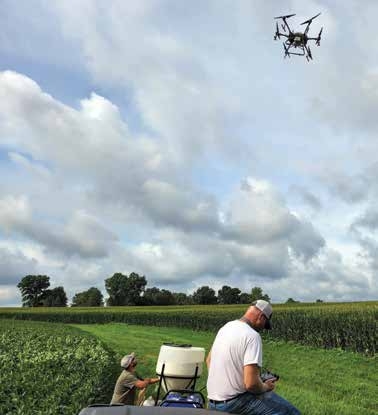
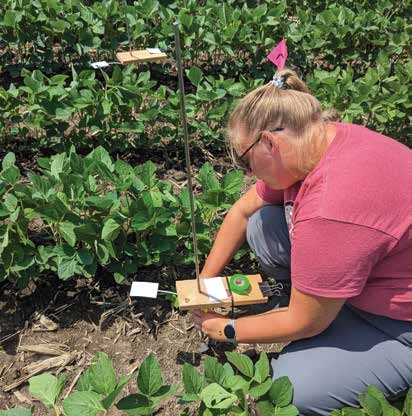
Researchers are examining ways to better understand the spray deposition and efficacy of spray drones to make proper application recommendations.
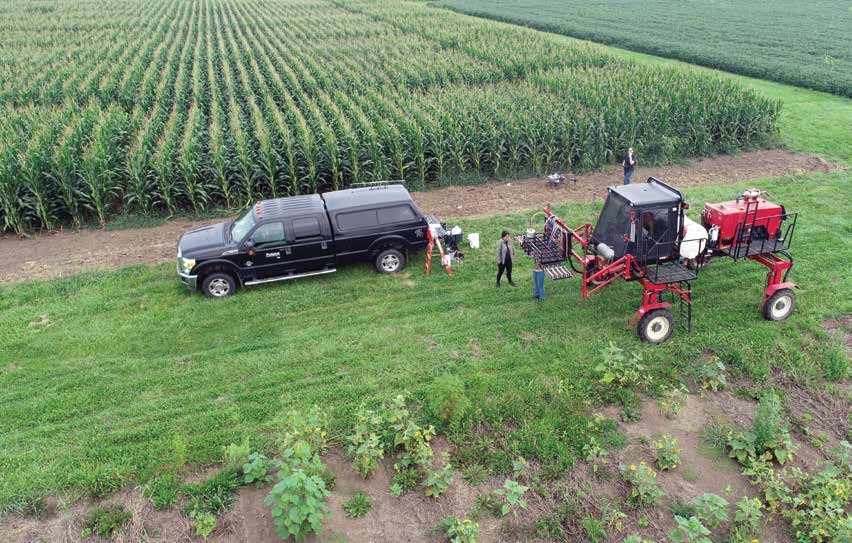
Agricultural researchers are investigating the similarities and differences between planes, drones, and ground rigs when applying the same product.
Researchers are investigating many questions that may change how drones apply pesticides in the future. The answers to these questions may also vary by drone manufacturer, model, and the overall size of the spray platform.
- What are optimum application heights?
- How will wind conditions, drone types, nozzle size/designs, or the types of pesticide being applied affect applications?
- Will spray heights vary by application type (spot versus broadcast)?
- What is the optimum carrier volume?
- Are there nozzles or droplet sizes that are better suited for drones?
- Are rotary nozzles better than traditional hydraulic nozzles?
- Will drones with linear booms perform spray differently than drones with individual nozzles immediately below the rotors?
- For drones with linear booms, what are the optimum boom lengths in relation to the location of the propellers?
- For boomless drones, what nozzle configurations and how many nozzles under the drones will provide the best applications?
- What spray nozzle pressures on drones will provide better coverage, efficacy, and reduced off-target movement?
- How do drone speeds affect spray coverage and pesticide efficacy?
- Is there an optimal flight speed where the overall application is optimized to maximize pest control and minimize spray drift?
- What drone speeds are best for canopy penetration?
- How wide can drones spray effectively?
- What application parameters affect rotor downwash?
- What are the best flight patterns for effective pesticide applications with drones? Is it along, across, or at an angle with the crop rows or the wind direction?
- How does the lack of agitation in spray drone tanks affect pesticide applications and efficacy?

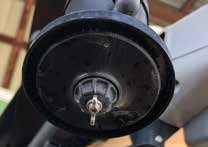
Some spray drones are equipped with common ground equipment nozzles (such as the XR nozzle at the top; however, these nozzles have much smaller orifice sizes than commonly used with ground applications. More modern spray drones use rotary atomizer (spinning disc) nozzles, like that observed on the DJI Agras T40 (bottom).
DRONE CONSIDERATION: What You Use Today Might Not Be Used Tomorrow
Drones were initially designed for capturing imagery and collecting data which largely remains true with today’s aircraft. Just because they are equipped with a solution tank, pump, and spray nozzles does not change what they were originally designed to do.
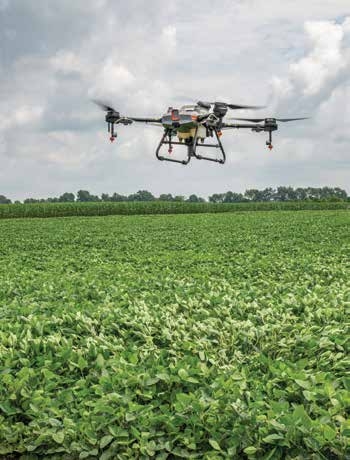
One of the many differences among drone models is how the spraying systems are equipped. This drone is equipped with conventional nozzles underneath the spray rotors.
We expect that the commercial use of spray drones will expand and be part of an evolution that will incorporate advances in spray system design, plumbing, nozzle placement, battery life, sensors, and pump specifications. There is no universal model, design, or software system that is currently considered an industry standard.
Eventually, certain designs with the greatest efficiencies and value will come to the forefront and become the standard of how a drone should be designed for spraying. This process will be similar to the development and adoption of precision ag equipment currently used in crop production where some level of compatibility and operation has been established.
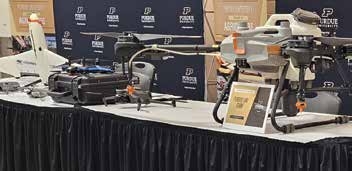
What you see demonstrated or sold today will be radically different from what you see tomorrow. Imaging and spray drones evolve with advanced technologies.
DRONE CONSIDERATION: Spray Drift Remains a Top Priority
Pesticides moving off-target during spraying is a major concern regardless of the equipment applicators use. It is nearly impossible to completely avoid spray drift. However, operators can minimize it by selecting the best application parameters, especially the nozzles, and operating them at optimal conditions. One of the parameters that affects pesticide drift is the distance the spray droplets must travel from the nozzle to the soil or crop target.
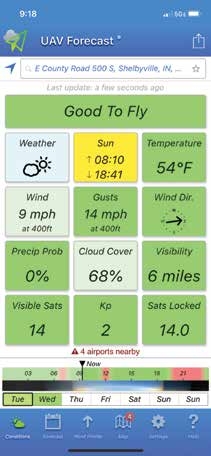
There are smartphone and tablet applications to determine if environmental conditions are suitable for application.
For ground equipment the typical recommendation is to have the booms about 24 to 30 inches from the target canopy or soil. Even at that relatively close height, spray drift is among the biggest challenges with ground sprayers. Of course, the rotor downwash from spray drones may influence the spray cloud and serve as an air curtain to help drive spray droplets down to the target. However, what percentage of the spray cloud is in the downward rotor downwash and is pushed either laterally away from the drone or upward into the wind current is unknown.
Preliminary results from a small number of studies indicate a drone flying higher than 10 feet above the crop canopy is likely to cause higher levels of off-target spray drift. Drift potential from spray drones is expected to increase considerably as flying speed and flight altitude increase. Boom configuration in hydraulic systems can also change drift potential based on where booms are placed on the drones and nozzle locations in that particular configuration. As with ground and manned aerial applications, boom configurations for drones must be tested for effective swath before field applications to ensure best practices.
DRONE CONSIDERATION: Regulations a Large Hurdle
Individuals who want to operate drones have many regulatory layers to navigate, which takes time. For example, the Federal Aviation Administration (FAA) requires drone operators to comply with several requirements. Some FAA restrictions include: drones must be registered, pilots need to pass an exam, pilots must maintain a visual line of sight with their drones, and operators must obtain permission to fly in restricted air space.
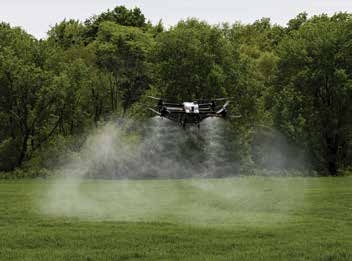
This photo shows the spray distribution and swath emitted from a DJI Agras T40 using rotary atomizer (spinning disc) nozzles.
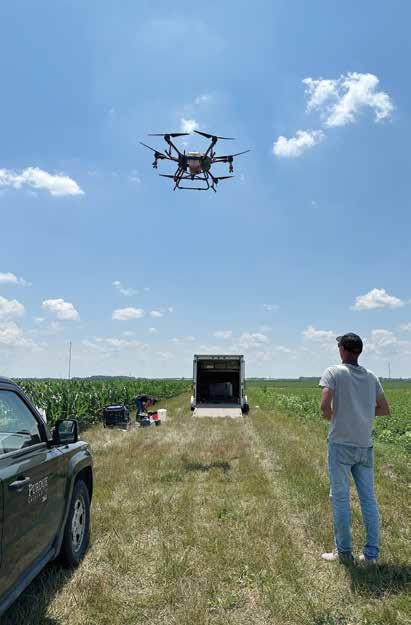
Nozzle type, spray height, and carrier volume are some of the factors researchers are evaluating to determine optimal spray drone applications.
Drone manufacturers have provided the capability to swarm, meaning one remote can operate several drones at once. If the drone is less than 55 pounds, swarming has been approved for up to five drones; however, the vast majority of spray drones operate above the 55-pound limit.
For many years, perhaps the most severe restriction was that operators could only fly one drone at a time without getting a waiver from the FAA when a drone weighs more than 55 pounds. This changed in 2024, when Hylio was granted FAA approval to fly three spray drones weighing more than 55 pounds with just one pilot and without an observer (docket ID FAA-2023-1833).
While swarming allows three drones to be flown with additional crew, that same crew of two now has three drones to refill at a time instead of just one, which would affect productivity. This has the potential to be a gamechanger for drone applications and treat larger agricultural operations more quickly.
However, the exemption or waiver process may take several months. Applicants must provide proof that the extra precautions pilots have proposed to be exempt from regulation will provide a similar standard of safety as the rule provides. However, it is expected that the FAA will reduce conditions requiring exemptions and the approval period for waivers will be expedited in the future.
DRONE CONSIDERATION: Expansion May Depend on Battery Innovations
What started off as a drone carrying two gallons of water has now increased to 18 gallons — and that increases with each new model. However, each additional gallon of water makes drones heavier. This increased weight reduces the time batteries remain sufficiently charged.
Smaller drones used for photographs can get upwards of 45 minutes from a single battery. For heavier spray drones, battery life has been reduced to approximately 7 to 12 minutes of flight. This means that each spray drone needs multiple spare batteries fully charged or actively being charged to keep the drone operating continuously over the course of a day’s operations. We expect that battery research fueled by the electric vehicle industry will lead to transferable technology that will power drone batteries in the future.
Another issue associated with batteries is how long they require to recharge. Battery recharging can take anywhere from 10 to 30 minutes depending on battery size, the type of charging power available (110 vs. 240 volts), and how hot the batteries are. Generators that are large enough to produce sufficient wattage to charge multiple batteries at once can be difficult to find, are extremely bulky, and price and quality range widely.
Newer drone models allow for a fast charge at 240 volts and 50 amps. This can reduce charging time if the power supply (generator) is rated to provide the full current the battery charger needs to operate most efficiently. Efficient drone operators will typically have several batteries so they can use one battery while the other two or more are being charged (or already charged) and ready to be swapped when drones land to refill.
DRONE CONSIDERATION:
Protecting Your Investment Will Require Insurance
With today’s drones costing $30,000 or more, crashing and destroying one without insurance coverage is risky. Flying without insurance is like buying a new truck and driving off the lot without coverage. When you have that much money invested in a drone, you don’t want to take a chance on an accident or being involved in a lawsuit. Some pesticide regulatory agencies require proof of liability insurance before they will issue the certifications or licenses necessary to operate a spray drone.
Two generally accepted types of insurance are hull and liability. Hull insurance protects the drone, while liability protects against whatever damage the drone causes. Currently, there are very limited options for insuring spray drones, but this too is rapidly changing. Limited availability often means insurance coverage for a drone can be expensive, especially for liability insurance. Some drone operators are paying $4,000 to $6,000 annually per unit, but this cost includes spray drift and other liability coverages. Since drones can be repaired relatively easily, some operators only choose to get liability coverage to reduce their premiums.
If you are interested in hiring a custom spray drone application, be sure to ask if the applicator is fully licensed specifically for spray drone applications, because the insurance is not the same as what is issued for ground applications. Accidents or off-target incidents that occur from custom spray drone applications not carrying insurance could result in legal ramifications for all of the parties involved — the farmers, customers, and applicators.
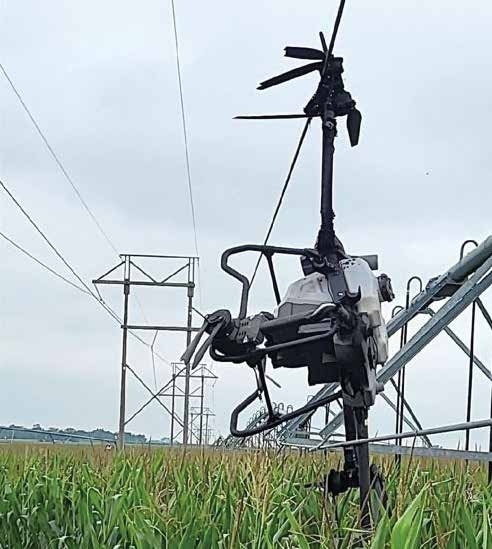
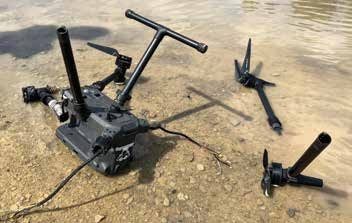
 A spray drone contacted a transmission line and irrigation pivot, knocking out the power line (top). Beyond the damaged equipment, what other liabilities could the operator be responsible for (middle and bottom)?
A spray drone contacted a transmission line and irrigation pivot, knocking out the power line (top). Beyond the damaged equipment, what other liabilities could the operator be responsible for (middle and bottom)? 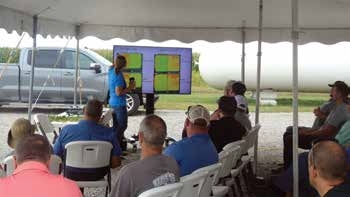 For operators unfamiliar with drone software or operation, trainings are often provided at a variety of educational programs.
For operators unfamiliar with drone software or operation, trainings are often provided at a variety of educational programs.